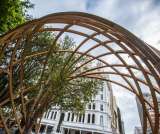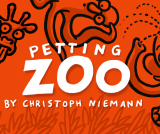
Two-thirds of all revenue earned by Cape Town accessories designer Katherine-Mary Pichulik is from exports. That’s some statistic when one considers Pichulik only started her business in May 2012.
When she applied to be an “Emerging Creative” in last year’s Design Indaba Expo, her wares were stocked in just two Cape Town boutiques. The exclusive Emerging Creatives programme – made possible by the Department of Arts and Culture – provides free floor space at the expo and mentoring to qualifying applicants.
“To have a weekend with R65 000 worth of accessories sold really allowed me to expand. Afterwards I could up my production, buy more materials in bulk and I hired another person,” she said.
Last year Pichulik rented a trestle table in a shared studio space with six other designers. This year she moved her team of 10 into a 106m2 space that’s all their own.
Pichulik was one of 486 exhibitors at the expo last year, of which 116 other designers were also new. For the expo in February next year, a quarter of all confirmed exhibitors so far are first timers. For newbie businesses that don’t have financial backing, and manufacture on demand, it’s a springboard into commerce writ large.
Accessories designer Friedel Harmsen studied jewellery design and describes herself as a self-taught graphic designer. She is exhibiting at the expo for the first time next year with a wearable art label she set up earlier this year called Love, Africa Studio.
Design Indaba for me is about that magical space between art and design. I like that it’s curated so strongly, and the local and international market that it draws is very intermingled in the art world.
Another first-time exhibitor, Rollin Vintage, is a four-person team that upcycles antique cutlery into jewellery. Since the products are only available in Durban – where the company is based – and elsewhere up north, the expo is an invaluable way to connect with Cape Town stockists and get the products known there, said Ryan Rollin.
“We started as a sideline so we didn’t really have the capacity to exhibit before. Now we’re full-time and it’s full steam ahead.”
In the US, the government recognises that entrepreneurs are the lifeblood of the economy. In that country, small firms create more jobs than big ones do.
In South Africa, the Department of Small Business Development was established in May. Minister Lindiwe Zulu said that the key in assisting small and medium enterprises (SMEs) was to create a support structure for connections to be made among them.
In the Financial Mail, shadow minister of small business development, DA MP Toby Chance, writes that 90 percent of the 11 million new jobs in the National Development Plan are expected to come from SMEs.
“The idea people are talking about in small business development circles is the ‘entrepreneurial ecosystem’. By this is meant the activities, enablers, conditions, stakeholders and incentives that make up the environment in which entrepreneurialism can exist and thrive,” Chance writes.
Design Indaba recognises this “entrepreneurial ecosystem” well. It provides a prolifically marketed networking platform with the expo and conference.
Its contribution to this economic stimulus is evident in the number of other design-oriented conferences and shows that have emerged locally over the years.
At the first expo in 2004, there were 40 exhibitors and two buyers. At the most recent one in February, there were 509 exhibitors and 806 buyers, 211 of whom were international.
The conference that happens simultaneously, and attracts global leaders in various design fields, provides the inspiration to the expo’s perspiration.
According to a report compiled by Barry Standish in association with UCT’s Graduate School of Business, exhibitors at the most recent expo in February earned R201.9 million in total income from business orders from buyers and sales to the public. Design Indaba created 575 direct jobs and 571 indirect jobs this year. In the past six years, Design Indaba has generated R1.7 billion to South Africa’s GDP.
These figures are not anecdotal. There are surveys filled in by exhibitors post-expo and sales figures and business orders collated.
Standish does all the analysis for conferences held at the CTICC so the statistic that the average visitor to the expo spent double that of any other expo held there is testament to its impact. The increasing number of jobs created year on year, as well as visitors – from 8 000 in 2004 to 40 967 in this year – is testament, too.
Photographer and product designer Ed Suter has exhibited at the expo six times. Prior to his first expo, he had never done a show before. “At some point I couldn’t believe it. The interest was enormous. I was really basking in confidence. To hear all that praise was the biggest motivator to continue,” he said.
From three in year one, Suter now has more than 40 different products in his range. From the first expo came orders to supply a range of shops countrywide.
From subsequent expos he’s had orders from Paris, Milan, Berlin, Lagos, San Diego and Namibia. He also met representatives from Mr Price at the expo for whom he has designed a “huge variety of products”.
“Design Indaba is where people get to see the products, feel them and talk to me, and that’s when they place orders. I think for anyone whose business is the same size as mine, it’s vital to be there. I just don’t know if my business would have continued without it. And being seen amongst other designers has been very important,” he said.
Pichulik’s sentiments are similar. “It’s great if you don’t have a flagship store: to connect with your market and understand your market. But for me what becomes more valuable than the sales is being part of that dialogue. It’s important to put oneself on the platforms where the African aesthetic is under discussion.”
Dominique Herman is a writer and editor and works for Design Indaba on a freelance basis.









